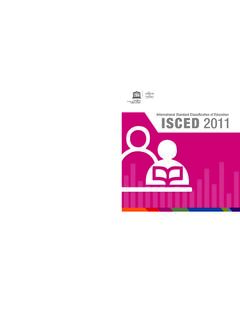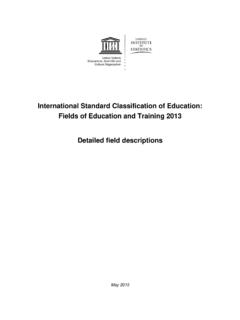Transcription of The Structure of the European Education Systems 2018/19 ...
1 Education and Training The Structure of the European Schematic Diagrams Eurydice Facts and Figures Education Systems 2018/19 The Structure of the European Education Systems 2018/19 Schematic Diagrams Eurydice Facts and Figures Education and Training This document is published by the Education , Audiovisual and Culture Executive Agency (EACEA, Education and Youth Policy Analysis). Please cite this publication as: European Commission/EACEA/Eurydice, 2018. The Structure of the European Education Systems 2018/19 : Schematic Diagrams. Eurydice Facts and Figures. Luxembourg: Publications Office of the European Union. ISBN 978-92 -9492-806-1 ISSN 2443-5333 EC-AL-18 -001-EN-N Text completed in September 2018. Education , Audiovisual and Culture Executive Agency, 2018. Reproduction is authorized provided the source is acknowledged.
2 Education , Audiovisual and Culture Executive Agency Education and Youth Policy Analysis Avenue du Bourget 1 (J-70 Unit A7) BE-1049 Brussels Tel. +32 2 299 50 58 Fax +32 2 292 19 71 E-mail: Website: 3 CONTENTS INTRODUCTION 5 Main organisational models of primary and lower secondary Education 5 GUIDE TO READ THE DIAGRAMS 6 Scope 6 Graphic layout 6 Age of students and programme duration scales 6 Levels and types of Education 7 Text 7 Connections between programmes 7 Compulsory Education /training 7 Key 8 Compulsory work experience and its duration 8 Programme being phased 8 International Standard Classification of Education ( isced 2011) 8 SCHEMATIC DIAGRAMS 11 ACKNOWLEDGEMENTS 33 5 INTRODUCTION This report focuses on the Structure of mainstream Education in European countries from pre-primary to tertiary level for the 2018/19 school and academic year.
3 Forty-three Education Systems are included covering 38 countries participating in the EU's Erasmus+ programme (28 Member States, Albania, Bosnia and Herzegovina, Switzerland, Iceland, Liechtenstein, Montenegro, Norway, Serbia, the former Yugoslav Republic of Macedonia and Turkey). The first section of the report sets out the main organisational models of primary and lower secondary Education ( isced 1-2) . The second one provides a guide on how to read the diagrams. The national schematic diagrams are shown in the third section. Main organisational models of primary and lower secondary Education The diagrams reveal three main organisational models of primary and lower secondary Education (ISCDE 1 and 2) which are part of compulsory Education in all European Education Systems . Single Structure Education . Education is provided from the beginning to the end of compulsory schooling, with no transition between primary and lower secondary Education , and with general Education provided in common for all pupils.
4 Common core curriculum provision. After successful completion of primary Education ( isced 1), all students progress to the lower secondary level ( isced 2) where they follow the same general common core curriculum. Differentiated lower secondary Education . After successful completion of primary Education , students are required to follow distinct educational pathways or specific types of schooling, either at the beginning or during lower secondary Education . In some countries students follow different tracks in vocational, technical or general Education . In others, they are enrolled in different types of general Education . At the end of studies they receive different levels of certificate. Main models of primary and lower secondary Education ( isced 1-2) in Europe, 2018/19 Source: Eurydice. Note: In the Czech Republic, Latvia, Hungary and Slovakia, compulsory Education is organised in a single Structure up to ages 14 to 16.
5 However, between ages 10 and 13, students in these countries can, at certain stages in their school career, enrol in separate establishments providing both lower and upper secondary Education . In Poland: due to the progressive restructuration of the school system, the organisational model of full-time compulsory Education has become a single Structure model. Single Structure ( isced 1 + isced 2) Common core curriculum ( isced 2) Differentiated branches/streams ( isced 2) 6 GUIDE TO READ THE DIAGRAMS The Guide to read the diagrams provides necessary information to understand and correctly interpret the content of the diagrams. It includes terminology, definitions, meaning of colours and symbols used for the graphic layout and short description of the International Standard Classification of Education ( isced 2011).
6 Scope The diagrams show the mainstream educational programmes considered to be the most representative in each country. They encompass: Early childhood Education and care provided in publicly subsidised and accredited centre based settings for children from the youngest age of enrolment. Primary and secondary Education programmes including the period of compulsory Education . Post-secondary non-tertiary programmes. Tertiary level main programmes. The diagrams do not show: o Educational provision intended exclusively to adults with low formal educational attainment and/or a low level of basic skills. The diagrams cover only the courses allowing adult to turn back to school or to gain further qualifications which are incorporated in mainstream educational programmes. Usually, these courses are integrated in the programmes providing competence-based qualifications at secondary educational level or allowing access to tertiary Education (post-secondary non-tertiary educational level) (1).
7 O Separate provision outside mainstream Education for children and young people with special educational needs. o At tertiary level, doctoral studies, as well as the specialised studies for the regulated professions such as medicine and architecture. Graphic layout The graphic layout of the diagrams is divided in two parts. The first part (left side bar) shows educational programmes from pre-primary to post-secondary non tertiary levels. The second one (right side bar) explains the main programmes at the tertiary level. Age of students and programme duration scales The 'age of students' scale shows the age of pupils and students when they start each level of Education from pre-primary onwards ( isced levels 0 to 4). These ages are notional and give an indication of the official age at which children might begin early childhood Education and care or compulsory Education .
8 Early or late entry, grade retention or other interruptions to schooling as well as adult learning are not taken into account. (1) For more information on main type of educational provision for adults, see European Commission/EACEA/Eurydice, 2015. Adult Education and Training in Europe: Widening Access to Learning Opportunities. [Online] Available at: The Structure of the European Education Systems 2018/19 : Schematic Diagrams 7 The 'programme duration' scale applies to tertiary level programmes and refers to the standard number of years necessary to complete studies at different stages on a full-time basis. The duration of part-time studies or individualised study patterns is not shown. Levels and types of Education The main bars of the diagrams show the national educational Systems ; different colours represent the different levels and types of Education .
9 The small vertical lines within the levels represent the division into cycles or key stages for primary and secondary Education , as well as the duration of qualifying programmes in post-secondary and tertiary Education . A second thin bar with coloured stripes indicates the corresponding levels of Education as defined by the International Standard Classification of Education ( isced 2011) (see description below). Text All terms are provided in the official national language(s) of the country. For most of the countries the type of institution is indicated. For other countries, where the same educational programme(s) can be provided by different types of institution, the type of Education or programmes is specified. All country notes are in English. Connections between programmes The diagrams also show the stages at which students may move to a different type of school or Education , either within a level or on completion of a level or programme.
10 These transition points are shown by the vertical lines linking to the programmes. However, as the number of possible transition routes increases in some countries as students' progress through the system, the pathways from secondary/post-secondary Education to tertiary Education programmes are not represented. Therefore, the conditions of entry to tertiary Education , even in the case of automatic progression, are not shown. Compulsory Education /training Full-time compulsory Education /training refers to a period of full-time educational/training attendance required of all students. This period is regulated by the law and usually determined by the students' age. Usually, full-time compulsory Education /training is provided in formal institutions/schools. However, in some Education Systems , certain compulsory Education /training programmes can combine part-time school based and part-time workplace courses.








